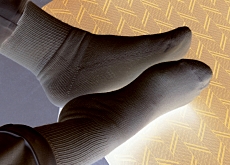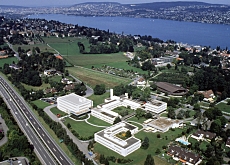Taking stock of tiny developments

Nanotechnology has been described as one of the century's key new technologies, but Swiss experts say determining its future impact remains difficult.
While nanoscience is widely expected to reap huge benefits, fears persist over potential harm to the environment and human health.
Experts gathered at a recent conference hosted by the Swiss Federal Laboratories for Materials Testing and Research took a broad look at its impact on science, health, society and the economy.
Nanoscience and nanotechnology involve studying and working with matter on an infinitesimal scale. One nanometre is one-millionth of a millimetre and a single human hair is around 80,000 nanometres in width.
Today, nanotechnology is still in at an early phase of its development.
“It’s the age of exploration and discovery – we’re rapidly expanding our capabilities,” Don Eigler, an IBM Research Fellow from California told swissinfo.
Eigler, whose work includes building new structures out of individual atoms, says nanoscience’s impact is becoming bigger by the day.
“Nanotechnology is not so widely deployed at the moment but it’ll come more and more, affecting many aspects of our lives,” he added.
Nanotechnologies are widely seen as having huge potential in areas as diverse as healthcare, information technology and energy storage. Governments and businesses across the world have started to invest substantially in their development.
For the federal laboratories, which are investigating and exploiting nanotechnologies as well as studying their impact on society, there is huge business potential for Swiss industry and small and medium-sized companies.
“We are actively contacting companies to offer our know-how and access to experimental facilities,” said the laboratories’ head, Louis Schlapbach.
“We are developing material technologies, improving products and creating new ones that might have short-term market opportunities.”
Special properties
Materials’ behaviour at the nanoscale is often very different from when they are in a larger form.
Nanomaterials can be stronger, lighter, more easily recyclable, and are often able to conduct heat or electricity in a different way; they can even change colour.
These special attributes are already being used in a number of ways, such as in semi-conductors, scratch-free paint, wrinkle and stain-resistant fabrics, sun lotions, skis and photographic paper.
But like most new technologies, the benefits of nanoscience have to be weighed up against any potential risks specialists warn.
Concern
While nanotechnology is expected to greatly benefit many areas of science and industry, nanoparticles could be a cause for concern.
Little research has been carried out internationally to determine their effects on people or the environment.
Semantics is crucial, according to Schlapbach.
“It’s very wrong to talk about the risk of nanotechnology when you are referring to nanoparticles.
“We need to learn more about the risks of nanoparticles to be able to handle them properly,” he added.
A 2004 study by the Royal Society in Britain concluded that many nanotechnologies pose no new risks to health, and that almost all the concerns relate to the potential impacts of deliberately manufactured nanoparticles and nanotubes, which are free rather than fixed to or incorporated in a material.
The federal laboratories are studying the potential risks of nanoparticles within the scope of the “NanoRisk” project, financed by the Swiss government, part of which considers effects on cells and cell metabolism.
Informed debate
Another crucial issue is public perception and transparency.
There is a lack of guidelines in Switzerland and in other countries to regulate the industry as well as wide-scale public ignorance about the benefits and risks.
There are also fears that the public will reject some forms of nanotechnology unless an informed public debate takes place involving all stakeholders.
“We owe it to ourselves to do a better job at communicating; it is important to engage the public on this issue as early as possible,” said Eigler.
swissinfo, Simon Bradley
Nanoscience and nanotechnology encompass a range of techniques rather than a single discipline, and stretch across the whole spectrum of science, touching on medicine, physics, engineering and chemistry.
The size and scale of the nanotechnology industry is unclear in Switzerland. One reason is that there is no international standard definition of the science, making it hard to determine whether companies use nanotechnology or not.
A 2004 report by the Royal Society in Britain estimated research and development on nanotechnology to be worth some SFr1.57 billion ($1.2 billion) a year in Europe.
This compares with $800 million in Japan in 2003, $3.7 billion for a US project lasting from 2005 to 2008 (excluding defence expenditure) and a pledge from the British government to spend $78.5 million a year on nanotechnology between 2003 and 2009.
A nanometre is one millionth of a millimetre.
Nanoparticles could be used in medicine as tiny drug capsules or to selectively direct treatment to cancerous tissues or to tag antibodies with crystals that show up under ultraviolet radiation.
Silver-coated textile fibres have an antibacterial effect and reduce body odours.

In compliance with the JTI standards
More: SWI swissinfo.ch certified by the Journalism Trust Initiative












You can find an overview of ongoing debates with our journalists here . Please join us!
If you want to start a conversation about a topic raised in this article or want to report factual errors, email us at english@swissinfo.ch.